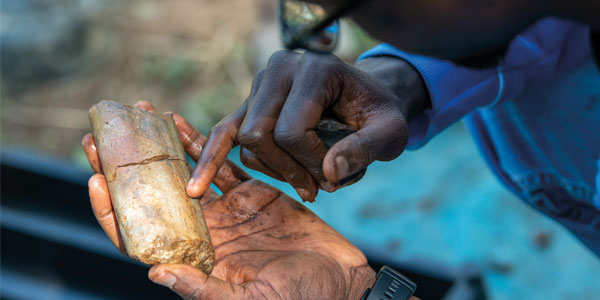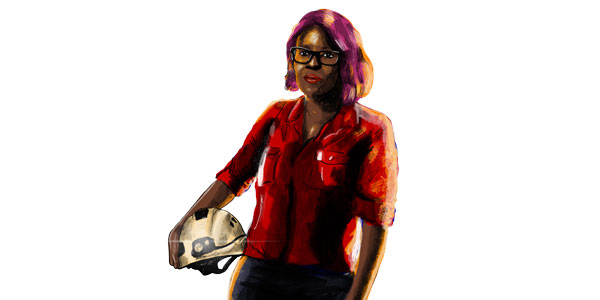
Digging for the truth of humanity
- Shaun Smillie
Wits researchers have over the past century changed, and challenged, the way we think about the evolution of humanity and our ancestors.

In the Cradle of Humankind, a group of scientists waited for the moment when they would know if they had struck pay dirt. The wait was for the first of 20 cores to come to the surface courtesy of a diesel-powered drilling rig.
That pay dirt, if all worked out, would be a core of tufa-freshwater carbonate rock that contains the fossilised remains of plants. Tufa is a variety of limestone formed when carbonate minerals precipitate out of ambient temperature water. It would allow a peek into what the environment and climate was like in this corner of the Cradle about 200 000 years ago.
“We will first see what is preserved, then get an age sequence of the unit and after that we look at the carbon and oxygen isotopes,” explains geologist Dr Tebogo Makhubela, the Principal Investigator at what is known as the Lefika la Noka tufa site. “This will give us an indication of vegetation type, the temperature, the amount of carbon dioxide in the atmosphere at the time, and rain levels.”
Birth of a species
Two hundred thousand years ago is a period in which palaeoanthropologists are starting to take a serious interest. This is the date range when it is thought that one of the latest additions to the evolutionary tree, Homo naledi, was wandering the Cradle.
“This will be the only nearly continuous environmental record for the interior of South Africa that exists,” says Wits palaeoanthropologist, Professor Lee Berger.
The search for Homo naledi and the world in which she lived is the continuation of a tradition of research that Wits has led for close on 100 years. In that time, there have been groundbreaking discoveries that have turned the understanding of our origins on its head.
Back in 1925, Wits Professor Raymond Dart revealed to the world the Taung child. Often referred to as the most significant palaeoanthropological find of the 20th Century, the fossilised skull would eventually prove that Africa was the birthplace of the human species.
Both the nature of research and the face of those who lead it has changed dramatically at Wits since Dart’s days. Innovative technologies are adding to our understanding of the past and a younger generation of academics have been given the chance to take charge of world-renowned dig sites.

Dr Keneiloe Molopyane is amongst this new generation of scientists, and she is the Principal Investigator at Gladysvale, which is situated close to the new Lefika la Noka tufa site. But Gladysvale is worlds away from those early dig sites when palaeoanthropologists like Dart, sporting stiff collars and ties, went about their business working on their own.
On the hill overlooking Gladysvale is a transmitter hooked up to provide high speed internet connectivity – part of a new ethos where everything is geared towards mobility. The infrastructure can be broken down and moved elsewhere quickly, and mobile labs allow for on-site analysis.
“It has definitely become more multidisciplinary,” says Molopyane. “We need geologists, palaeoanthropologists and everyone to work together on modern dig sites.”
But just as 200 000 years ago is the new hunting ground for a mystery relative, there is another period in distant human history that has Wits scientists scratching their heads, and on a quest to find out more.
Jewels, tools and graffiti
Something started happening to humans around 120 000 years ago. It was during this time that they began expressing themselves through art, wearing jewellery and using new hunting technologies. Evidence for this change has been found in cave sites, many of which hug the South African coastline, including the Blombos Cave, Klipdrift Shelter, Pinnacle Point, Sibudu Cave, Klasies River Caves and Border Cave.
In 2018, what is believed to be the earliest evidence of a human “drawing” was revealed by Professor Christopher Henshilwood, who holds the Department of Science and Technology/National Research Foundation South African Research Chair in the Origins of Modern Human Behaviour at Wits and is the Director of the Centre for Early Sapiens Behaviour at the University of Bergen in Norway.
The drawing was a series of red criss-crossed lines of ochre on a piece of grindstone found at Blombos Cave in the southern Cape in South Africa. The artefact was dated to between 70 000 and 100 000 years old. Besides this early art, archaeologists at Blombos and other sites have found shell beads covered in ochre and sophisticated leaf-shaped stone spear points.
“We can see that this period was key to human brain development, and it is probably associated with syntactic language,” says Henshilwood.
Trying to figure out what caused that spark deep in the Middle Stone Age means drawing on new disciplines and technology.
“Part of our group are psychologists,” says Henshilwood. “We are working on functional magnetic resonance imaging that records areas of your brain that light up as you do certain things, such as making a stone tool. This helps us to trace how human brains might have been organised in the past.”
Together with several world-first discoveries – such as the discovery by Professor Lyn Wadley and her team of the first grass bedding that people used 200 000 years ago, and the first evidence of early human beings cooking and eating starch 120 000 years ago, by Professor Sarah Wurz and her team – Wits researchers have revolutionised the way we think and contributed to knowledge of our ancestors.
Why did we live here?
Jerome Reynard, Senior Lecturer in the School of Geography, Archaeology and Environmental Studies at Wits, is another new generation scientist. He is trying to figure out why humans took to living in the highlands that border what is now Lesotho and the Eastern Cape some 20 000 years ago, at the height of the Glacial Maximum. Conditions then would have been brutal. Temperatures were well below freezing and what is now the mountain kingdom would have been dotted with mini glaciers.
“Why they would have lived in the highlands when there were warmer conditions just down the mountains below, is a mystery,” says Reynard.
He plans to dig at a site called Strathalan, near Nqanqarhu (Maclear) where he hopes to solve the mystery and work out how people survived in such hostile conditions.
“So how do people adapt to those environments? Did they adapt by, for example, increasing social networks? Or did they become more isolated?” he asks.
A bright future for the past
Back at the Lefika la Noka tufa site, in the Cradle, the shout went out. The drillers had found something. Makhubela laid out the core on a wrap of heavy-duty plastic. It exposed a core of tufa, drilled from about four metres deep. This newly unearthed time-capsule could begin to unravel a new chapter in the century-long search into human origins that began when Dart described the Taung skull in 1925, and then spent the next three decades defending his discovery against a world opinion with preconceived ideas on how human evolution worked.
Since Dart’s days, Wits has continued to populate the evolutionary family tree with new discoveries such as Australopithecus sediba and Little Foot, and has challenged notions, ideas and long-held traditions and misconceptions that have advanced our understanding of the origins of humankind.
This, believes Berger, will continue.
“The future lies in building strong and dynamic science with scientists, explorers and technicians,” he says. “This future looks brighter than ever with this new generation of discoverers, who are curious about the world, and who are making a plethora of discoveries.”
- Shaun Smillie is a freelance writer.
- This article first appeared in Curiosity, a research magazine produced by Wits Communications and the Research Office. Read more in the 14th issue, themed: #Wits100 where we celebrate a century of research excellence that has shaped today and look forward to how our next-generation researchers will impact the next 100 years.

